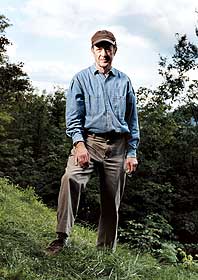
“If anything in the world can make you look forward to turning 70, the Subway Series is it,” says Steve Reich, pondering his milestone birthday this October. Though Reich comes off like your basic fast-talking New York native, he isn’t referring to the Mets and Yankees—he means the huge birthday celebration he’s getting at the city’s most powerful performing-arts institutions. In an unusual partnership arranged for “Steve Reich @ 70,” each will focus on a different aspect of the composer’s work: BAM is doing dance, Carnegie Hall is presenting music written for specific performers as well as a young artists’ workshop, and Lincoln Center is focusing on his vocal music.
Though Reich, who lives much of the year in Vermont, is not quite as widely known as his contemporary Philip Glass, he is nonetheless one of the most important composers alive. But although he and Glass have a certain amount in common—oddly, they once owned a moving company together, and used to collaborate musically as well—their music is not the same. Glass’s music can seem to be the continual development of a specific theme, while Reich’s rhythmically driven compositions tend to be more varied, utilizing digital sampling and electronics more than Glass, and branching out from a strict Minimalist aesthetic. (For his part, Reich brushes off the Minimalist label, saying it “doesn’t make any sense at all.”)
His compositions have been played by the New York Philharmonic, Sonic Youth, and an awful lot of people in between, including the jazz guitarist Pat Metheny, who will join the birthday party in October at Carnegie Hall. Metheny will perform Electric Counterpoint, a piece Reich wrote for him, for the first time since its premiere at BAM almost twenty years ago. “I actually think I’ll be able to play it quite a bit better now,” Metheny says. “I was struggling with it at the time. The sort of down-stroke thing that his music requires—it really demanded this kind of Joey Ramone–type playing,” he explains, laughing. (The original is on Nonesuch’s five-CD Reich boxed set, out this fall.)
BAM’s celebration inevitably focuses on Anne Teresa De Keersmaeker, who’s choreographed more work to Reich’s music than anyone else has. Her 1982 breakthrough, Fase, set to Reich, will be revived there in October. Why is she so drawn to his music? “There’s an extreme simplicity, but also extreme complexity,” she says. “It has a beautiful balance, in having an intellectual rigor and at the same time being extremely close to popular music. And being very ‘pulsative’—that’s an important thing for dance.”
The other striking thing about Reich’s work is its connection with the news. One of his signal works is the 1965 It’s Gonna Rain, which plays tricks with a tape loop of a street preacher’s Cold War–era rant. His latest in this vein is Daniel Variations, mixing text from the Book of Daniel and the words of slain Wall Street Journal reporter Daniel Pearl. (A talk with Pearl’s father inspired him to write it, and the string parts evoke Pearl’s own fiddle playing.) The U.S. premiere will be with Reich’s ensemble, Music for 18, plus a string quartet, at Carnegie Hall. And a collaboration with his artist wife, Beryl Korot—the video opera Three Tales, a jarring look at technology that invokes the Hindenburg, the A-bomb, and cloned sheep—is at the Whitney.
Though Reich was one of the first electronic-music superstars, “I need a break from electronics,” he says today. “I really need a long period of working with instruments and singing voices.” Except that his birthday party is getting in the way. “I will snatch a few moments on an airplane, no doubt, but there’s gonna be very little composition going on. But, you know,” he says, “some problems are better than others.”
—Steve Reich @ 70, Carnegie Hall, Lincoln Center, BAM, and the Whitney Museum of American Art; throughout October. Next: The Next Generation of New York Ballet